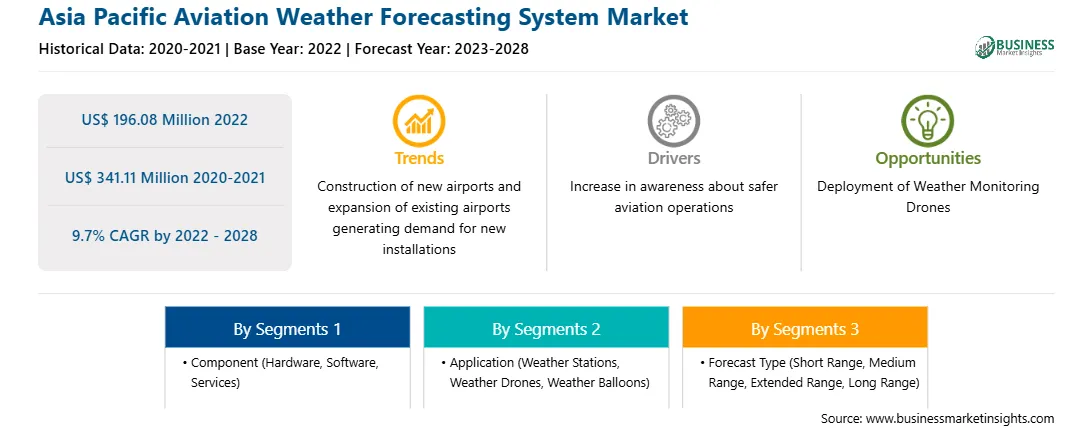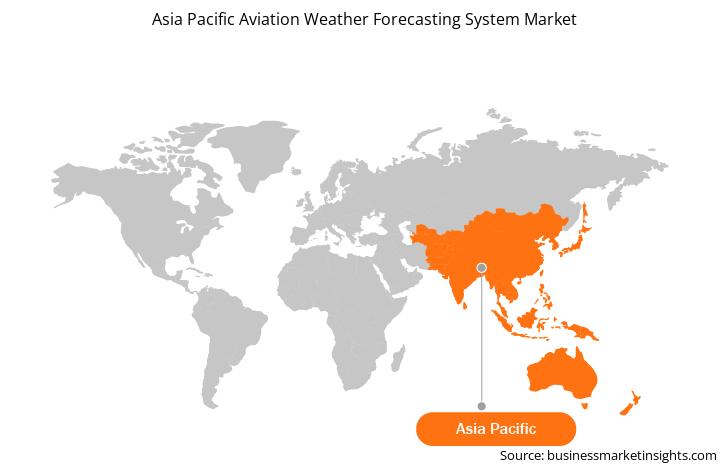The growing air passenger traffic is catalyzing the procurement of commercial aircraft fleets. To cater to the increasing passenger traffic and rising aircraft fleet, several countries—such as China, India, and Japan—that have large air traffic volume have already made their plans for building new airports across their respective regions. For instance, the Melbourne International Airports started its renovation activities in 2021. Similarly, the construction of Western Sydney Airport started in November 2021. According to several aviation sources, seven of the top 10 expensive airport projects that entered the execution phase in 2021 are in Asia. Such factors are expected to generate future opportunities for aviation weather forecasting systems and services during the forecast period across Asia Pacific. For instance, according to the plans released by the Civil Aviation Administration of China (CAAC) in 2021, China has already planned to build 215 airports by the end of 2035, which is one of the major factors expected to catalyze the demand for aviation weather forecasting systems during the forecast period. According to the plans released by the Civil Aviation Ministry of India in 2022, the country plans to initiate 220 new airport projects by 2025. Hence, construction of new airports and expansion of existing ones are likely to generate demand for aviation weather forecasting systems and services during the forecast period.

Strategic insights for the Asia Pacific Aviation Weather Forecasting System provides data-driven analysis of the industry landscape, including current trends, key players, and regional nuances. These insights offer actionable recommendations, enabling readers to differentiate themselves from competitors by identifying untapped segments or developing unique value propositions. Leveraging data analytics, these insights help industry players anticipate the market shifts, whether investors, manufacturers, or other stakeholders. A future-oriented perspective is essential, helping stakeholders anticipate market shifts and position themselves for long-term success in this dynamic region. Ultimately, effective strategic insights empower readers to make informed decisions that drive profitability and achieve their business objectives within the market.

| Report Attribute | Details |
|---|---|
| Market size in 2022 | US$ 196.08 Million |
| Market Size by 2028 | US$ 341.11 Million |
| Global CAGR (2022 - 2028) | 9.7% |
| Historical Data | 2020-2021 |
| Forecast period | 2023-2028 |
| Segments Covered |
By Component
|
| Regions and Countries Covered | Asia-Pacific
|
| Market leaders and key company profiles |
The geographic scope of the Asia Pacific Aviation Weather Forecasting System refers to the specific areas in which a business operates and competes. Understanding local distinctions, such as diverse consumer preferences (e.g., demand for specific plug types or battery backup durations), varying economic conditions, and regulatory environments, is crucial for tailoring strategies to specific markets. Businesses can expand their reach by identifying underserved areas or adapting their offerings to meet local demands. A clear market focus allows for more effective resource allocation, targeted marketing campaigns, and better positioning against local competitors, ultimately driving growth in those targeted areas.

The Asia Pacific aviation weather forecasting system market is segmented on the basis of component, application, forecast type, and country. Based on component, the market is categorized into hardware, software, and services. In 2022, the hardware segment held the largest share of the market and is expected to register the highest CAGR during the forecast period. By application, the Asia Pacific aviation weather forecasting system market is divided into weather stations, weather drones, weather balloons, and others. The weather stations segment held the largest market share in 2022, and the weather drones segment is expected to register the highest CAGR in the market during the forecast period. In terms of forecast type, the Asia Pacific aviation weather forecasting system market is segmented into short-range, medium-range, extended-range, and long-range. The short-range segment held the largest market share in 2022 and is expected to register the highest CAGR in the market during the forecast period. From country point of reference, the Asia Pacific aviation weather forecasting system market is segmented into Australia, China, India, Japan, South Korea, and Rest of APAC. In 2022, China held the largest market share, and India is expected to register the highest CAGR during the forecast period.
Campbell Scientific, Inc.; Collins Aerospace; IBM Corporation; Universal Weather and Aviation, Inc.; Sutron; UBIMET; Vaisala; DTN; and Spire Global are among the leading companies operating in the Asia Pacific aviation weather forecasting system market.
The Asia Pacific Aviation Weather Forecasting System Market is valued at US$ 196.08 Million in 2022, it is projected to reach US$ 341.11 Million by 2028.
As per our report Asia Pacific Aviation Weather Forecasting System Market, the market size is valued at US$ 196.08 Million in 2022, projecting it to reach US$ 341.11 Million by 2028. This translates to a CAGR of approximately 9.7% during the forecast period.
The Asia Pacific Aviation Weather Forecasting System Market report typically cover these key segments-
The historic period, base year, and forecast period can vary slightly depending on the specific market research report. However, for the Asia Pacific Aviation Weather Forecasting System Market report:
The Asia Pacific Aviation Weather Forecasting System Market is populated by several key players, each contributing to its growth and innovation. Some of the major players include:
The Asia Pacific Aviation Weather Forecasting System Market report is valuable for diverse stakeholders, including:
Essentially, anyone involved in or considering involvement in the Asia Pacific Aviation Weather Forecasting System Market value chain can benefit from the information contained in a comprehensive market report.